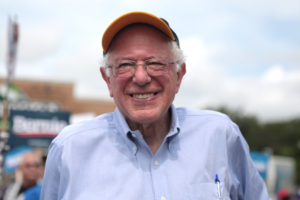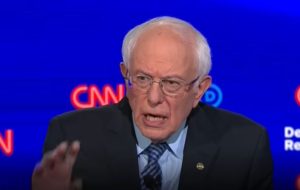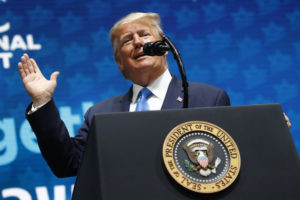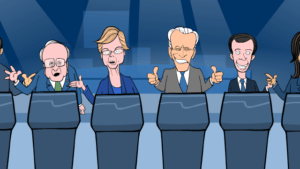The Most Important Election of Your Life Is Not This Year
The real nightmare is likely to emerge in 2020 or thereafter, if and when a far more capable politician than Donald Trump embraces retrograde positions and rides an angry, wounded America into Washington. Nick Kenrick / CC-BY-2.0
1
2
3
Nick Kenrick / CC-BY-2.0
1
2
3
It’s been notoriously difficult to characterize the Trump constituency. It’s much easier to identify the people who will never vote for him: Latinos angered by his racist taunts about Mexican immigrants and a federal judge, women outraged by his sexual innuendo and misogyny, and virtually everyone with an advanced degree. Writing off these constituencies — particularly women, since they constituted 53% of the electorate in 2012 — should doom Trump’s presidential bid.
Yet Trump is proving to be a guilty pleasure for many voters, like binge-watching a TV show about a serial killer or eating an entire quart of artery-clogging premium ice cream. The urge to vote for him is something that some Americans will never admit to outside the curtained privacy of the voting booth. But he scratches an itch. He’s the electoral equivalent of a day at the firing range, a way of blowing off political steam.
Trump voters tend to be overwhelmingly white, middle-aged, lower-income men whose education stopped at high school. They are not stupid, nor are they, as Thomas Frank argued about working-class Republican voters in his astute book What’s the Matter with Kansas?, voting against their own economic interests. Trump may be a billionaire, but he has articulated an economic policy that diverges from the naked plutocracy of the party of Mitt Romney.
He has opposed trade deals that outsource American jobs, supported higher taxes for “hedge-fund managers,” and declared his commitment to saving Social Security, Medicare, and Medicaid. Yes, of course, Trump has also made statements directly contradicting these positions or aligned himself with politicos who take the exact opposite stances. But the billionaire has constructed an image of himself as a triumphant version of an “average Joe” (with billions in pocket change) that plays well in America B. Whether consciously or not, he has taken a page from the Europe B playbook by combining positions skeptical of the unrestrained free market with a lot of nationalist bluster. It bears a family resemblance to fascism, but the American variant is firmly anchored in the kind of individual initiative celebrated on The Apprentice.
What also sets Trump apart is his commitment to making “America great again.” His opponents have tried to argue that America is already great, has been great, and will always be great. But the truth is, for many Americans, things have not been so great for at least the last two decades.
This line, more than Trump’s intemperate rants and off-the-cuff insults, is what ultimately distinguishes America A from America B. At a time when the American economy is growing at a respectable pace and the unemployment rate is below 5% for the first time since 2008, America B has not benefitted from the prosperity. It has suffered, not profited, from the great transformation the country has gone through since 1989 (and was particularly hard hit by the near economic meltdown of 2007-2008).
After all, it wasn’t just the former Communist world that experienced a transition at the end of the twentieth century.
Transitions Are U.S.
In the 1990s, the United States changed its political economy. It was not quite as dramatic a shift as the regime changes that took place across Eurasia, but it had profound consequences for the realignment of voting patterns in America.
During that decade, the U.S. economy accelerated its shift from manufacturing — along with the well-paying blue-collar jobs that sector had once generated — to an ever more dominant service economy. In terms of employment, manufacturing jobs dropped from 18 million in 1990 to 12 million in 2014, while wages for such jobs tumbled as well. Over that same period, the health-care and social assistance sector alone grew from 9.1 million to more than 18 million jobs. At one end of that service economy were the 1% in financial services making stratospheric sums, particularly as compensation packages soared from the mid-1990s on. On the other end were the people who had to add shifts at McDonald’s or Walmart to their full-time jobs or monetize their spare time by driving for Uber just to make what they or their parents once earned with one job at the local factory.
America was not alone in undergoing this shift. Thanks to technological innovations like computers and robotics, greater access to cheap labor in places like Mexico and China, the rise of the Internet, and the deregulation of the financial world, the global economy was being similarly transformed. Blue-collar workers no longer played as vital a role in any advanced economy.
In the U.S., put bluntly, the imagination of America A no longer needed the muscle of America B.
At one time in its history, government programs narrowed the gap between economic winners and losers through taxes and the entitlement programs they supported. But “small government” fever — which had remarkably little to do with actually reducing the size of government — swept the United States in the 1980s, first in the Republican Party of Ronald Reagan and then in the “reinvent government” faction of the Democratic Party. In the 1990s, they would collaborate across the aisle to slash assistance to low-income people. The resulting political (and economic) realignment created some notorious ironies, including the fact that Richard Nixon, with his wage-and-price controls and environmental policies, was a far more liberal president in the early 1970s than the Democratic Party standard bearer of the 1990s, Bill Clinton.
Your support matters…Independent journalism is under threat and overshadowed by heavily funded mainstream media.
You can help level the playing field. Become a member.
Your tax-deductible contribution keeps us digging beneath the headlines to give you thought-provoking, investigative reporting and analysis that unearths what's really happening- without compromise.
Give today to support our courageous, independent journalists.






You need to be a supporter to comment.
There are currently no responses to this article.
Be the first to respond.